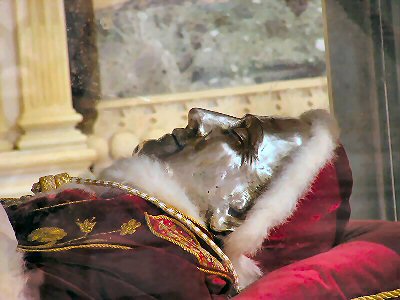A homily
by Fr. Eric M. Andersen, Sacred Heart in Gervais, OR
February 7th, 2013
Bl. Pius IX, pope
The Roman Martyrology for the seventh day in the Ides of
February:
At Rome,
blessed Pius IX, pope, who, plainly proclaiming the truth of Christ, near to
whom indeed he cleaved, instituted many episcopal sees, promoted the cultus of
the blessed Virgin Mary and approved the First Vatican Ecumenical Council.
And
elsewhere, many other holy martyrs, confessors, and holy virgins.
Thanks be
to God.
Pope Pius IX was born into a noble family in 1792 and
baptized Giovanni-Maria Mastai-Ferretti. As a child he suffered from epileptic
fits, but they ceased and his health improved as he grew older. His ordination
to the priesthood was even called into question due to his epileptic condition
“but the difficulty was settled by the favor of Pope Pius VII, and it was in
memory of his patron that (he later) took the name of Pius IX when he was
crowned” pope 27 years later in 1846 (The
Popes, ed. Eric John, p. 438).
His predecessor, Pope Gregory XVI had neglected the Papal
States and they had been reduced to a police state near bankruptcy. Pius IX
elevated the way of life for the people of the Papal States and he was very
beloved to the people of Italy. But many assumed that he supported Italian
nationalism (cf. 45). He was caught in an impossible situation when a mob
demanded that he declare war on Austria. While he was the monarch of the Papal
States, he was also the Pope––the spiritual father to the whole world and the
vicar of Jesus Christ. He could not declare war on Catholic Austria. So, he was
labeled an ‘anti-nationalist’ and “Denounced as a traitor to his country” (46).
He had to flee the country in disguise and he took refuge in the Kingdom of
Naples for 17 months.
Meanwhile the Papal States had been taken over by the mob and declared a democratic republic. Foreign troops from France, Austria, Naples, and Spain came to the help of the Pope and restored the Papal States to him in 1850. 1850 was also the year that the Pope restored the Catholic hierarchy to England and Wales. Shortly after this, in 1854, he declared the dogma of the Immaculate Conception of the Blessed Virgin Mary.
Meanwhile the Papal States had been taken over by the mob and declared a democratic republic. Foreign troops from France, Austria, Naples, and Spain came to the help of the Pope and restored the Papal States to him in 1850. 1850 was also the year that the Pope restored the Catholic hierarchy to England and Wales. Shortly after this, in 1854, he declared the dogma of the Immaculate Conception of the Blessed Virgin Mary.
Meanwhile, the French Emperor Napoleon III came to favor
a unified Italy and with his support, by 1860, the Italians reduced the Papal
States to include only the city of Rome. The Pope now “saw the Church as a
citadel under siege from all sides” and in response, he released the encyclical
Quanta Cura with the attached “Syllabus of Errors.” Now, he began
organizing and preparing for an Ecumenical Council. In 1870 the Council
convened but was interrupted by the invasion of Rome by Garibaldi and his
troops. King Victor Emmanuel seized Rome as the capital of Italy and Pope Pius
IX became ‘the prisoner of the Vatican’ (47).
Persecution was rampant. Catholics were being persecuted
in Switzerland and France. Three years later in Germany, “the government
claimed full control of the Catholic schools, the education of the clergy and
all clerical appointments” (John, 439). The Pope suffered through these last
eight years of his life as he watched world events with great sorrow. He died
on February 7th, 1878 at the Vatican. He was beatified by Pope John Paul II in
the Great Jubilee Year 2000.


No comments:
Post a Comment